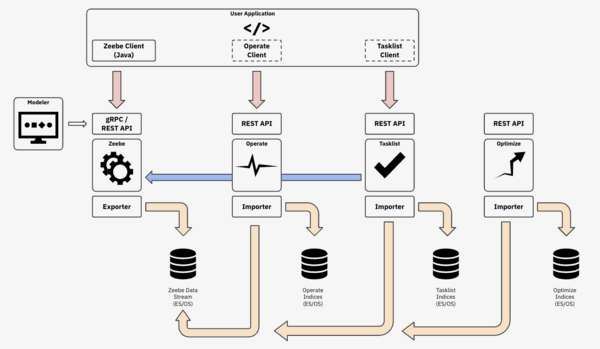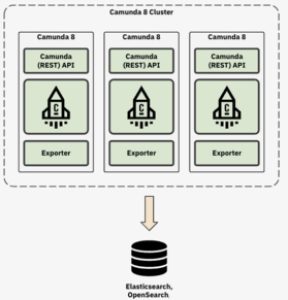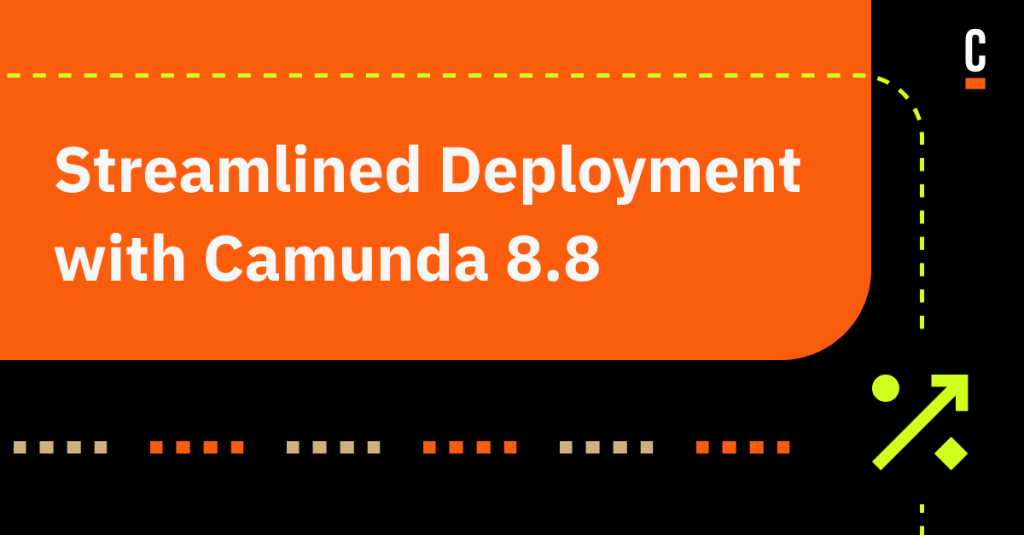As announced in this blog post, Camunda 8.8 will bring several improvements to simplify and improve deployment and management. Camunda 8.8 alpha 1 introduces a refined architecture, updated deployment options, and an improved developer experience. Overall, it’s designed to make process automation more accessible and efficient. Let’s go over some of the key updates.
Simplified architecture for easy installation and getting started
Camunda 8.8 introduces a streamlined architecture that unifies core components—Zeebe, Operate, Tasklist, and Identity—into a single, production-ready distribution. By consolidating these components into a single deployable package, Camunda 8.8 reduces deployment complexity, simplifies resource configuration, and streamlines resource management. This approach makes installation and setup more straightforward, whether you’re preparing a production environment or just getting started with Camunda.
You can download the alpha release of the unified package as an executable Java application (Camunda Orchestration Core), available in our GitHub repository. For more information, we encourage you to watch this presentation from CamundaCon New York.
In earlier versions, each component of the Camunda Orchestration cluster—such as Zeebe, Tasklist, Operate, and Optimize—was deployed independently, either as separate deployments or within a StatefulSet (see Diagram 1). While Zeebe could support a fully distributed deployment model, components like Operate and Tasklist were often run as single instances. This previous approach added complexity, requiring individual scaling, configuration, and monitoring.

With Camunda 8.8, most components are merged into a single deployable package, available as a JAR file or Docker container. Optimize will continue to be deployed separately due to its architecture and importer requirements.
Camunda 8.8’s unified approach reduces the complexity of managing multiple independent services and minimizes the overhead involved. Additionally, the new exporter architecture (see Diagram 2) removes the need to deploy Operate, Tasklist, and Identity as separate services, further streamlining deployment.

This single deployable package simplifies resource configuration, management, and monitoring. For Kubernetes Helm deployments, starting from Camunda 8.8 alpha 1, Camunda Orchestration Core uses a single StatefulSet to run all components of the orchestration cluster. It consolidates computing resources into a single deployment, allowing for horizontal/vertical scaling while maintaining high availability (HA) and disaster recovery (DR) for all Camunda components. This approach reduces operational complexity, making it easier to manage and scale as needed.
The Identity component in Camunda 8.8 will also change how it is installed and configured:
- First, it will be integrated into a unified deployment package along with Zeebe, Tasklist, and Operate, streamlining deployment and reducing configuration complexity by bundling all major components together.
- Second, Identity will use Zeebe’s persistence storage instead of a PostgreSQL server, which enhances system consistency and reduces the need to manage additional databases.
- Third, Identity will be decoupled from Keycloak; while Keycloak is still supported, you can now use OpenID Connect (OIDC) to integrate directly with any compatible identity provider (IDP) of your choice. To learn more about the changes to the Identity component, please see the Identity blog post.
Upgrade Camunda 8.7 deployment to version 8.8
The upgrade path from version 8.7 to 8.8 is straightforward if you are using the recommended Camunda 8 deployment options—specifically, Helm Charts. Our charts will support the upgrade directly, simplifying the transition.
Additional upgrade considerations are necessary for deployments that use custom scripts, such as Docker containers, manual installations, or custom-developed Kubernetes deployments. In these cases, you can either continue to deploy with your original 8.7 topology and upgrade each component independently or adopt our Helm Chart approach for the upgrade, which allows for unifying the deployment into a single JAR or container executable.
With the 8.8 release, we’ll publish further guidance to help you upgrade from 8.7 to 8.8, providing detailed steps and best practices to ensure a smooth transition.
During the upgrade from Camunda 8.7 to 8.8 with Helm Charts, Zeebe will remain operational. However, minimal downtime may be required to migrate the Identity database. Operate and Tasklist may also require a brief downtime while these components are moved to a unified stateful set.
These interruptions are expected to be minimal. We recommend planning for this short downtime window to ensure that service disruptions are minimized and any impact is well managed.
Enhanced deployment options
Camunda 8.8 supports several deployment platforms, including Kubernetes (e.g., AWS EKS, Azure AKS, GKS, or OpenShift), manual installation (e.g., AWS EC2, VMWare VMs, etc.), container services (e.g., Docker Compose, AWS ECS, etc.), and local development using Camunda 8 Run or Kind.
Camunda 8.8 introduces a set of deployment reference architectures aimed at providing practical solutions for different deployment needs. These reference architectures are designed to help you understand and implement Camunda effectively based on your specific infrastructure requirements:
Kubernetes deployment with AWS EKS
This reference architecture outlines best practices for deploying Camunda on Amazon EKS. It covers infrastructure setup, resource scaling, and cluster management to ensure your Camunda environment is scalable and resilient. The architecture also provides guidance on integrating with other AWS services, such as AWS OpenSearch, AWS IAM, and HashiCorp Terraform.
Manual installation on AWS EC2
For organizations that do not use cloud-native platforms like Kubernetes or container services, this reference architecture provides guidance on implementing Camunda production clusters on AWS EC2 instances. It includes details on optimal instance sizing, network configurations, and security best practices to ensure robust performance and reliability.
While these provided reference architectures focus on specific platforms, we encourage you to use them as a foundation for deploying Camunda in their own unique environments or configurations. We plan to include detailed guides for Azure Kubernetes Service (AKS), OpenShift, and AWS container services in upcoming releases, providing more comprehensive deployment options for diverse infrastructures.
Kubernetes Helm Chart production deployment guide
With the 8.8 release, we plan to publish a new guide that explores the deployment of Camunda in Kubernetes. The guide will provide a detailed overview of the deployment process, including configuration options that enhance reliability, security, and scalability. It will also cover a variety of topics customers need to know to successfully deploy the Camunda Orchestration cluster in production.
Introducing Camunda 8 Run for pro developers
Camunda 8 Run, first released in version 8.6, is designed specifically for local development and testing, providing a lightweight setup without the need for a full-scale cluster. Camunda 8.8 will enhance C8Run to better meet the needs of professional developers:
- Local development and testing: Camunda 8 Run offers an easy way to run Camunda on a local machine, making it perfect for development and experimentation. It eliminates the need for a complex setup or a full Kubernetes cluster, allowing developers to get started quickly and focus on building and testing workflows.
- Integrated components: Camunda 8 Core Orchestration Cluster includes essential components like Zeebe, Operate, Tasklist and now Identity in one package. This integration ensures a seamless developer experience by providing all core functionalities needed for process automation in a single environment.
- Enhanced developer experience: By streamlining setup and bundling all necessary tools, C8Run helps developers iterate quickly, test new features, and validate workflows without the overhead of managing a distributed deployment.
Ideal use cases for Camunda 8 Run
Camunda 8 Run is perfect for local development and testing scenarios. It provides a lightweight setup that is easy to configure, making it an excellent choice for developers who need a fast and simple environment to build and experiment with process automation. Camunda 8 Run allows for efficient workflow testing without the complexity of managing high availability, failover, or scaling concerns, which are typically needed in production environments.
More sophisticated platforms—like Kubernetes or infrastructure as service (IaC) systems such as ArgoCD, Ansible, or Terraform—are recommended for production-grade deployments requiring advanced capabilities (e.g., high availability, enterprise-level security, and resilience). This makes Camunda 8 Run an optimal solution for rapid prototyping and local experimentation and for smoothly transitioning to full-scale production deployments using Camunda Orchestration Core.
Frequently asked questions about deployment in Camunda 8.8
What are the main differences between Camunda 8.7 and 8.8?
Among other changes, Camunda 8.8 introduces a streamlined architecture, consolidating core components like Zeebe, Operate, and Tasklist into a single deployable unit, simplifying deployment and management.
It also provides enhanced deployment options such as new Kubernetes Helm guides, deployment reference architectures, and improved support for professional developers through Camunda 8 Run.
Can I use Camunda 8 Run for production environments?
Camunda 8 Run is primarily designed for local development and testing, providing a lightweight and easy-to-set-up environment. However, for those interested in running Camunda as a single deployable unit in production, we will soon publish a detailed guide on how to deploy the unified Jar file in a production setting.
This guide will provide the right way to leverage the benefits of a new architecture (such as simplicity of installation, as in the case of Camunda 8 Run) while ensuring scalability, high availability, and enterprise-grade security for production environments.
What deployment options are available for Camunda 8.8?
Camunda 8.8 can be deployed using Kubernetes with Helm Charts (e.g., AWS EKS, Azure AKS, or OpenShift), manually using a JAR on a VM or any other infrastructure platform, Docker Image (e.g., Docker-Compose or AWS ECS), or using C8Run, Docker-compose, or Kind for local development.
Will there be any downtime when upgrading from Camunda 8.7 to 8.8?
Zeebe might experience minimal downtime as it migrates Identity data into a new schema. Operate and Tasklist may experience small downtime while their pods are restarted with the new version. We recommend planning for this small window of potential downtime. More details will be outlined in the update guide published on the release date of Camunda 8.8.



Start the discussion at forum.camunda.io